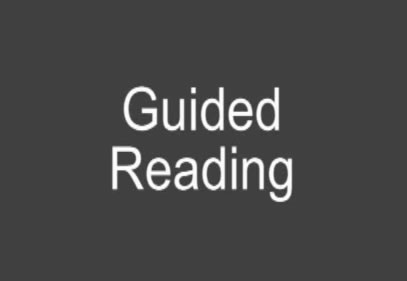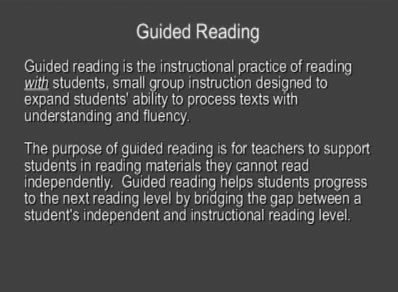Guided reading is the instructional practice of reading withstudents. It is a key component of a balanced literacy program. Guided reading is small group instruction designed to expand students' ability to process texts with understanding and fluency. The purpose of guided reading is for teachers to support children in reading materials they cannot read independently and is therefore used frequently with emergent, early and transitional readers. Guided reading helps students progress to the next reading level by bridging the gap between a student's independent and instructional reading level. (The instructional reading level is usually one level above the independent reading level.)
Guided reading groups are fluid and flexible since they are based on students' ever changing instructional and independent reading levels. To keep guided reading groups flexible, teachers continually assess and observe students through guided reading, one on one reading conferences, independent reading and running records. Using these informal and formal assessments, teachers are able to group together students with similar reading abilities. As students' reading levels change over time, as evidenced by the ongoing assessment data collected, the teacher regroups strudents and provides the necessary instruction which is based on the identified needs.
Guided reading groups typically follow a similar structure. During a guided reading session, for instance, the teacher introduces a book to the students, distributes copies of the text to each student, observes and guides each student while they read the text and provides additional teaching to the small group after the reading. The text chosen for each guided reading session reflects the needs and instructional reading level of the students gathered. Guided reading is different from traditional reading groups because each student is responsible for independently reading the whole text or a unified part of it rather than just a page or sentence.
The overall emphasis of guided reading is for students to read many books along a gradient of increasing complexity and challenge as well as develop a repertoire of reading strategies that they can transfer to their independent reading (Fountas and Pinnell, 1999).
Guiding Reading 1
Guided Reading 2
Carleen, P., Payne, C. & Schulman, M. (2000). Guided Reading: Making It Work. New York, NY: Scholastic.
Fountas, I. & Pinnell, G.S. (2007). Continuum of Literacy Learning, Grades K-2. Portsmouth, NH: Heinemann.
Fountas, I. & Pinnell, G.S. (2007). Continuum of Literacy Learning, Grades 3-8. Portsmouth, NH: Heinemann.
Fountas, I. & Pinnell, G.S. (1996). Guided Reading. Portsmouth, NH: Heinemann.
Fountas, I. & Pinnell, G.S. (2000). Guiding Readers & Writers. Portsmouth, NH: Heinemann.
Fountas, I. & Pinnell, G.S. (2001). Leveled Books for Readers, Grades 3-6. Portsmouth, NH: Heinemann.
Fountas, I. & Pinnell, G.S. (1999). Matching Books to Readers. Portsmouth, NH: Heinemann.
Fountas, I. & Pinnell, G.S. (2006). Teaching for Comprehending and Fluency. Portsmouth, NH: Heinemann.
Schulman, M. (2006). Guided Reading in Grades 3-6: Everything You Need to Make Small-Group Reading Instruction Work In Your Classroom. New York, NY: Scholastic.


